[English] 日本語
 Yorodumi
Yorodumi- PDB-7y82: CryoEM structure of type III-E CRISPR Craspase gRAMP-crRNA comple... -
+ Open data
Open data
- Basic information
Basic information
| Entry | Database: PDB / ID: 7y82 | ||||||
|---|---|---|---|---|---|---|---|
| Title | CryoEM structure of type III-E CRISPR Craspase gRAMP-crRNA complex bound to self RNA target | ||||||
 Components Components |
| ||||||
 Keywords Keywords | RNA BINDING PROTEIN / Nuclease / STRUCTURAL PROTEIN-RNA COMPLEX | ||||||
| Function / homology | CRISPR type III-associated protein / RAMP superfamily / defense response to virus / RNA binding / RNA / RNA (> 10) / RNA (> 100) / RAMP superfamily protein Function and homology information Function and homology information | ||||||
| Biological species |  Candidatus Scalindua brodae (bacteria) Candidatus Scalindua brodae (bacteria) | ||||||
| Method | ELECTRON MICROSCOPY / single particle reconstruction / cryo EM / Resolution: 2.83 Å | ||||||
 Authors Authors | Zhang, J.T. / Cui, N. / Huang, H.D. / Jia, N. | ||||||
| Funding support | 1items
| ||||||
 Citation Citation |  Journal: Nat Commun / Year: 2022 Journal: Nat Commun / Year: 2022Title: Structural basis for the non-self RNA-activated protease activity of the type III-E CRISPR nuclease-protease Craspase. Authors: Ning Cui / Jun-Tao Zhang / Zhuolin Li / Xiao-Yu Liu / Chongyuan Wang / Hongda Huang / Ning Jia /  Abstract: The RNA-targeting type III-E CRISPR-gRAMP effector interacts with a caspase-like protease TPR-CHAT to form the CRISPR-guided caspase complex (Craspase), but their functional mechanism is unknown. ...The RNA-targeting type III-E CRISPR-gRAMP effector interacts with a caspase-like protease TPR-CHAT to form the CRISPR-guided caspase complex (Craspase), but their functional mechanism is unknown. Here, we report cryo-EM structures of the type III-E gRAMP and gRAMP-TPR-CHAT complexes, before and after either self or non-self RNA target binding, and elucidate the mechanisms underlying RNA-targeting and non-self RNA-induced protease activation. The associated TPR-CHAT adopted a distinct conformation upon self versus non-self RNA target binding, with nucleotides at positions -1 and -2 of the CRISPR-derived RNA (crRNA) serving as a sensor. Only binding of the non-self RNA target activated the TPR-CHAT protease, leading to cleavage of Csx30 protein. Furthermore, TPR-CHAT structurally resembled eukaryotic separase, but with a distinct mechanism for protease regulation. Our findings should facilitate the development of gRAMP-based RNA manipulation tools, and advance our understanding of the virus-host discrimination process governed by a nuclease-protease Craspase during type III-E CRISPR-Cas immunity. | ||||||
| History |
|
- Structure visualization
Structure visualization
| Structure viewer | Molecule:  Molmil Molmil Jmol/JSmol Jmol/JSmol |
|---|
- Downloads & links
Downloads & links
- Download
Download
| PDBx/mmCIF format |  7y82.cif.gz 7y82.cif.gz | 329.1 KB | Display |  PDBx/mmCIF format PDBx/mmCIF format |
|---|---|---|---|---|
| PDB format |  pdb7y82.ent.gz pdb7y82.ent.gz | 249.9 KB | Display |  PDB format PDB format |
| PDBx/mmJSON format |  7y82.json.gz 7y82.json.gz | Tree view |  PDBx/mmJSON format PDBx/mmJSON format | |
| Others |  Other downloads Other downloads |
-Validation report
| Summary document |  7y82_validation.pdf.gz 7y82_validation.pdf.gz | 1.2 MB | Display |  wwPDB validaton report wwPDB validaton report |
|---|---|---|---|---|
| Full document |  7y82_full_validation.pdf.gz 7y82_full_validation.pdf.gz | 1.3 MB | Display | |
| Data in XML |  7y82_validation.xml.gz 7y82_validation.xml.gz | 50.4 KB | Display | |
| Data in CIF |  7y82_validation.cif.gz 7y82_validation.cif.gz | 74.7 KB | Display | |
| Arichive directory |  https://data.pdbj.org/pub/pdb/validation_reports/y8/7y82 https://data.pdbj.org/pub/pdb/validation_reports/y8/7y82 ftp://data.pdbj.org/pub/pdb/validation_reports/y8/7y82 ftp://data.pdbj.org/pub/pdb/validation_reports/y8/7y82 | HTTPS FTP |
-Related structure data
| Related structure data |  33678MC 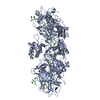 7y80C 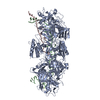 7y81C 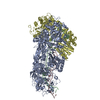 7y83C 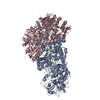 7y84C 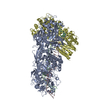 7y85C M: map data used to model this data C: citing same article ( |
|---|---|
| Similar structure data | Similarity search - Function & homology  F&H Search F&H Search |
- Links
Links
- Assembly
Assembly
| Deposited unit | 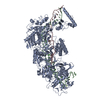
|
|---|---|
| 1 |
|
- Components
Components
| #1: Protein | Mass: 198652.688 Da / Num. of mol.: 1 Source method: isolated from a genetically manipulated source Source: (gene. exp.)  Candidatus Scalindua brodae (bacteria) / Gene: SCABRO_02597 / Production host: Candidatus Scalindua brodae (bacteria) / Gene: SCABRO_02597 / Production host:  | ||||
|---|---|---|---|---|---|
| #2: RNA chain | Mass: 35432.090 Da / Num. of mol.: 1 Source method: isolated from a genetically manipulated source Source: (gene. exp.)  Candidatus Scalindua brodae (bacteria) / Production host: Candidatus Scalindua brodae (bacteria) / Production host:  | ||||
| #3: RNA chain | Mass: 18097.795 Da / Num. of mol.: 1 / Source method: obtained synthetically / Source: (synth.)  Candidatus Scalindua brodae (bacteria) Candidatus Scalindua brodae (bacteria) | ||||
| #4: Chemical | ChemComp-ZN / #5: Chemical | ChemComp-MG / | Has ligand of interest | Y | |
-Experimental details
-Experiment
| Experiment | Method: ELECTRON MICROSCOPY |
|---|---|
| EM experiment | Aggregation state: PARTICLE / 3D reconstruction method: single particle reconstruction |
- Sample preparation
Sample preparation
| Component |
| ||||||||||||||||||||||||||||||
|---|---|---|---|---|---|---|---|---|---|---|---|---|---|---|---|---|---|---|---|---|---|---|---|---|---|---|---|---|---|---|---|
| Source (natural) |
| ||||||||||||||||||||||||||||||
| Source (recombinant) |
| ||||||||||||||||||||||||||||||
| Buffer solution | pH: 8 | ||||||||||||||||||||||||||||||
| Specimen | Embedding applied: NO / Shadowing applied: NO / Staining applied: NO / Vitrification applied: YES | ||||||||||||||||||||||||||||||
| Vitrification | Cryogen name: ETHANE |
- Electron microscopy imaging
Electron microscopy imaging
| Experimental equipment |  Model: Titan Krios / Image courtesy: FEI Company |
|---|---|
| Microscopy | Model: FEI TITAN KRIOS |
| Electron gun | Electron source:  FIELD EMISSION GUN / Accelerating voltage: 300 kV / Illumination mode: SPOT SCAN FIELD EMISSION GUN / Accelerating voltage: 300 kV / Illumination mode: SPOT SCAN |
| Electron lens | Mode: BRIGHT FIELD / Nominal defocus max: 2500 nm / Nominal defocus min: 1500 nm |
| Image recording | Electron dose: 50 e/Å2 / Film or detector model: GATAN K3 (6k x 4k) |
- Processing
Processing
| CTF correction | Type: PHASE FLIPPING ONLY |
|---|---|
| 3D reconstruction | Resolution: 2.83 Å / Resolution method: FSC 0.143 CUT-OFF / Num. of particles: 76820 / Symmetry type: POINT |
 Movie
Movie Controller
Controller







 PDBj
PDBj

































